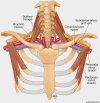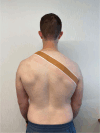Current Clinical Concepts: Rehabilitation of Thoracic Outlet Syndrome
- PMID: 39048118
- PMCID: PMC11277273
- DOI: 10.4085/1062-6050-0138.22
Current Clinical Concepts: Rehabilitation of Thoracic Outlet Syndrome
Abstract
Thoracic outlet syndrome (TOS) involves inconsistent symptoms, presenting a challenge for medical providers to diagnose and treat. Thoracic outlet syndrome is defined as a compression injury to the brachial plexus, subclavian artery or vein, or axillary artery or vein occurring between the cervical spine and upper extremity. Three common subcategories are now used for clinical diagnosis: neurogenic, arterial, and venous. Postural position and repetitive motions such as throwing, weightlifting, and manual labor can lead to symptoms. Generally, TOS is considered a diagnosis of exclusion for athletes due to the poor accuracy of clinical testing, including sensitivity and specificity. Thus, determining a definitive diagnosis and reporting injury is difficult. Current literature suggests there is not a gold standard diagnostic test. Rehabilitation has been shown to be a vital component in the recovery process for neurogenic TOS and for arterial TOS and venous TOS in postoperative situations.
Keywords: TOS; arterial; neurogenic.
© by the National Athletic Trainers' Association, Inc.
Figures








References
Publication types
MeSH terms
LinkOut - more resources
Full Text Sources
Medical

